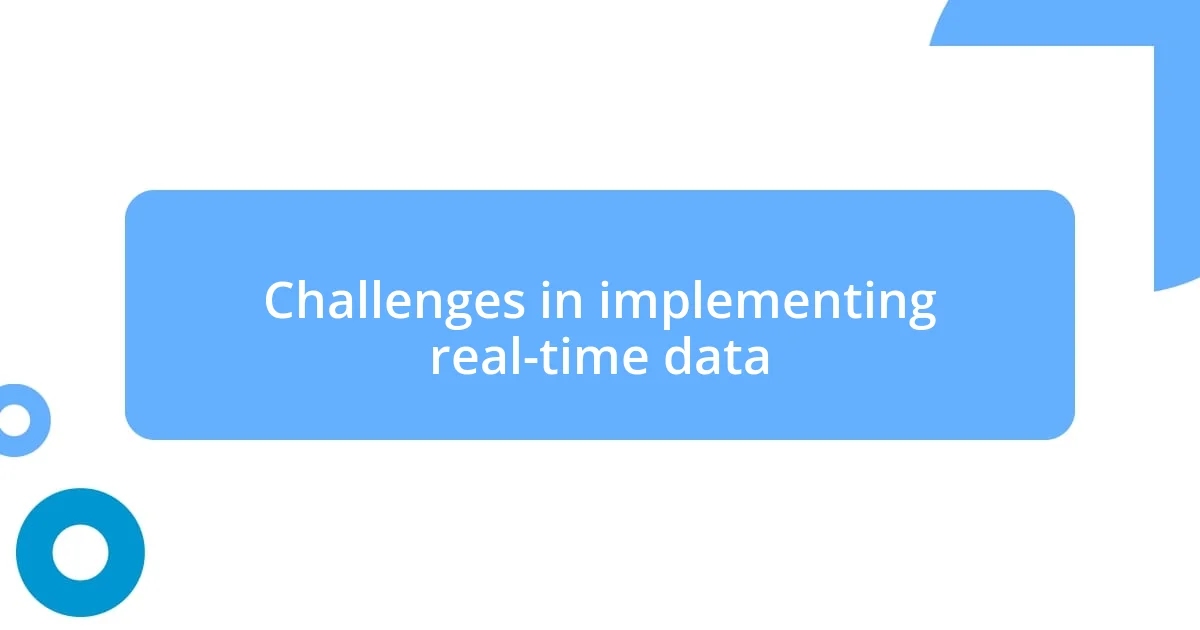Key takeaways:
- Real-time data processing enhances decision-making and allows immediate responses, transforming interactions with information across various industries.
- Key technologies like Apache Kafka, Flink, and Spark Streaming facilitate swift data analysis and seamless data flow, highlighting the importance of blending tools with creativity.
- Challenges in real-time data implementation include maintaining data integrity, addressing skill gaps among teams, and managing infrastructure costs effectively.

Understanding real-time data processing
Real-time data processing is essentially about making informed decisions in the moment. Imagine sitting in a control room, where every second counts; that’s the intensity I felt during my time working on a live tracking system. The thrill of watching data flow seamlessly, enabling immediate responses, is something I’ll never forget.
What fascinates me is how real-time data can transform the way we interact with information. Have you ever thought about how quickly systems need to react during a stock market crash? I remember a day when I saw real-time analytics predicting shifts in market trends almost instantaneously, which was nothing short of magical. It created a sense of urgency and possibility, showing how critical timely data really is.
Finally, the interplay between technology and human insight is vital. It’s incredible how algorithms can process vast amounts of information faster than our thoughts, but I often wonder—can they truly replace human intuition? During my projects, I found that while data provides answers, it’s our interpretations that lead to innovation and deeper understanding.

Benefits of real-time data insights
Real-time data insights offer a plethora of benefits that can elevate decision-making to a whole new level. I remember a project where we implemented real-time analytics for customer behavior tracking. The instant feedback allowed us to adjust marketing strategies on the fly, leading to a significant uptick in customer engagement. It was empowering to see the direct impact of our decisions, turning what could have been a missed opportunity into a real-time success story.
Here are some key benefits of real-time data insights:
- Immediate Decision-Making: Enables businesses to respond promptly to changes in the market.
- Enhanced Customer Experience: Tailors interactions based on up-to-the-minute information.
- Increased Operational Efficiency: Streamlines processes by identifying bottlenecks in real time.
- Data-Driven Strategy Adjustments: Supports agile business strategies with continuous feedback.
- Better Risk Management: Allows for proactive steps to mitigate risks as they arise.
Reflecting on my experiences, the ability to pivot quickly based on live data is not just a convenience; it’s a game-changer. When I think of the countless times we adapted our strategies in real-time, it reinforces the idea that being reactive can turn into a proactive advantage, helping businesses stay ahead of the curve.

Key technologies for data processing
Real-time data processing relies on several key technologies that enable the swift analysis of information as it’s generated. One standout technology is Apache Kafka, a distributed streaming platform that allows for the continuous flow of data between sources and destinations. I remember working alongside Kafka in a project, feeling the pulse of the data streams—it was exhilarating to see how messages could be processed in real-time with minimal latency, creating a backbone for our system.
In addition to Kafka, stream processing frameworks like Apache Flink and Apache Spark Streaming are essential. They allow for complex event processing, enabling businesses to glean insights from patterns in data as they happen. I vividly recall using Spark Streaming to analyze social media feeds during a product launch. Watching trends emerge in real-time was like being part of a live conversation, where every comment and reaction shaped our immediate responses and strategies.
Finally, data storage solutions such as Apache Cassandra or Amazon DynamoDB provide the necessary foundation for handling vast amounts of data efficiently. Their ability to support high-speed transactions and scale seamlessly made it an easy choice. Working with these technologies has often made me realize that, while tools are critical, blending them with creativity can unleash unprecedented potential in the world of data processing.
| Technology | Key Feature |
|---|---|
| Apache Kafka | Distributed streaming platform enabling real-time data flow. |
| Apache Flink | Stream processing framework for complex event processing. |
| Apache Spark Streaming | Real-time data stream processing with analytics capabilities. |
| Apache Cassandra | Highly scalable database designed for high-speed transactions. |
| Amazon DynamoDB | NoSQL database offering seamless scalability and high performance. |

Challenges in implementing real-time data
Implementing real-time data processing certainly comes with its array of challenges. One major hurdle I encountered was ensuring data integrity while processing streams at such high speeds. Picture this: I was knee-deep in data integration, and a sudden surge in traffic made it difficult to maintain consistent accuracy. How do you balance speed and accuracy without losing trust in your data? It became clear to me that having robust validation mechanisms in place is essential to mitigate such risks.
Another issue that often rears its head is the technical skill gap within teams. I remember during a training session, trying to explain the complexities of stream processing to colleagues who were more accustomed to batch processing. It felt like speaking a different language. Ensuring that everyone is on the same page, comfortable with the technologies, and can leverage them effectively isn’t just a nice-to-have; it’s critical for the success of any real-time initiative.
Finally, let’s not overlook the costs associated with maintaining infrastructure. In my experience, investing in high-performance servers and scaling solutions can quickly add up. I found myself questioning if the ROI justifies the spending, especially if you’re at the beginning of your real-time data journey. Asking tough questions about cost-effectiveness can be daunting, but it also opens the door to innovative solutions and better resource management.

Real-time data processing use cases
Real-time data processing is revolutionizing various industries, and I’ve had the chance to witness its impact firsthand in several use cases. For instance, in the financial sector, I worked on a project where we monitored transactions in real-time to detect fraudulent activities. It was incredibly fulfilling to see alerts pop up almost instantly as suspicious patterns emerged, allowing teams to act swiftly and protect clients. Isn’t it remarkable how these systems can literally save people from financial ruin?
In e-commerce, I’ve observed how companies utilize real-time data to enhance customer experiences. During a peak shopping season, I watched a retailer leverage real-time analytics to adjust their inventory based on live customer behavior. The ability to pivot quickly based on what shoppers were putting in their carts felt like being backstage at a concert—thrilling and dynamic! It’s amazing how real-time processing can turn a mundane shopping experience into something extraordinarily responsive and tailored.
Moreover, in healthcare, real-time data processing can be a lifesaver. I had the opportunity to collaborate on a project that monitored patient vital signs continuously. It was incredible to see how anomalies were flagged instantly, enabling medical staff to respond without delay. Can you imagine the difference it makes to catch a critical issue as it happens, rather than relying on periodic checks? The stakes are, quite literally, life and death, and that reality made our work feel profoundly meaningful.













